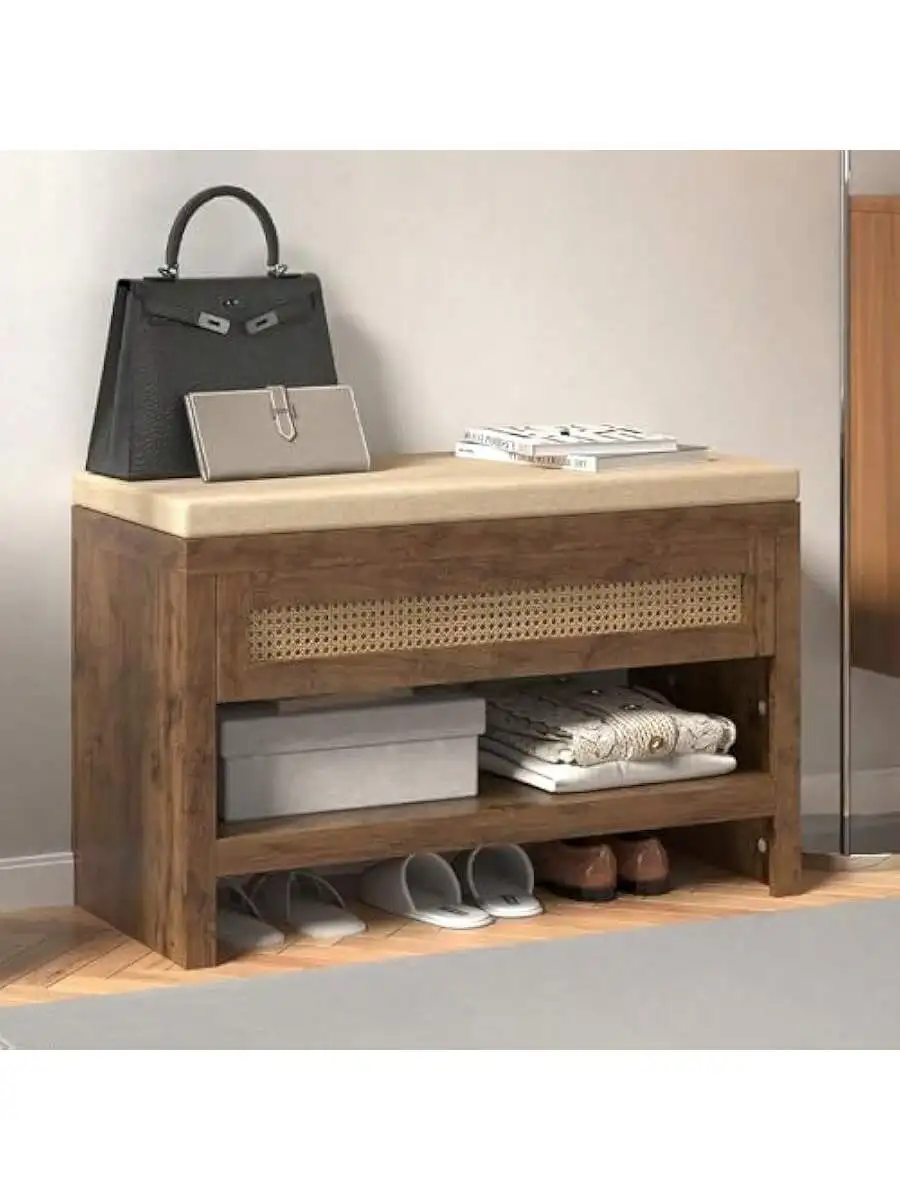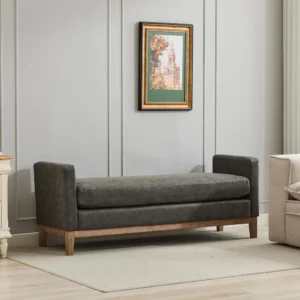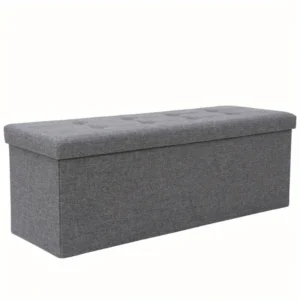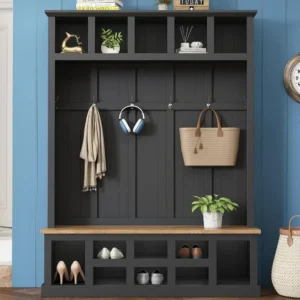Transform Your Entryway with Multi-Functional Seating
The entryway of your home serves as both the first impression for guests and the transition zone between outside chaos and indoor serenity. Multi-functional entry seating has surged in popularity because it elegantly solves multiple challenges at once: providing a place to sit while putting on or removing shoes, creating storage for everyday items, and enhancing your home’s aesthetic appeal.
Modern homes benefit tremendously from these versatile pieces that create effective “drop zones” – designated areas where family members can deposit bags, shoes, keys, and other daily essentials. A well-designed entryway with multi-functional seating can transform a previously cluttered space into an organized, welcoming area that sets the tone for your entire home.
The average household accumulates about 5-7 pairs of shoes per person in entryway areas, not to mention seasonal gear like umbrellas, hats, and gloves. Multi-functional entry seating addresses these organization challenges while offering benefits like:
- Maximized space efficiency in areas that are often limited in square footage
- Reduced visual clutter through hidden storage compartments
- Increased functionality through thoughtful design elements
- Enhanced aesthetic appeal with pieces that complement your home’s style
The impact of a well-designed entryway can be dramatic – transforming a once chaotic dumping ground into a structured, welcoming space that functions smoothly for everyday life. Revolutionizing your entryway with smart seating doesn’t just improve organization; it fundamentally changes how you experience coming home each day.
Whether you’re working with a grand foyer or a modest apartment entry, today’s market offers countless options for transforming your entryway with stylish benches featuring hidden storage. Let’s explore the possibilities for creating an entryway that beautifully balances form and function.
Hall Trees: The Complete Entryway Command Center
Hall trees represent the most comprehensive multi-functional entryway solution available, essentially creating a complete command center for your home’s entrance. These substantial pieces combine multiple storage and organizational elements in one cohesive unit, making them ideal for families with varied storage needs.
Traditional hall trees often incorporate mirrors and ornate detailing, while modern designs emphasize clean lines and maximum functionality. Rustic versions typically feature natural wood finishes and industrial hardware for a farmhouse-inspired look.
The integrated elements of a well-designed hall tree typically include:
- Bench seating for comfortable shoe changes
- Coat hooks or hanging rods for jackets, bags, and accessories
- Storage cubbies for shoes, hats, gloves, and other small items
- Sometimes drawers or cabinets for items requiring concealed storage
- Optional mirrors for last-minute appearance checks
Most hall trees range from 36-72 inches wide and 16-20 inches deep, making them substantial pieces that work best in entryways with adequate wall space. The typical bench seat supports 250-300 pounds, while individual hooks generally accommodate 10-15 pounds each – perfect for hanging coats, bags, and accessories.
Material choices significantly impact both aesthetics and durability. Solid wood hall trees offer exceptional sturdiness and classic appeal but come at a premium price point. Engineered wood provides a more budget-friendly alternative while still offering attractive finishes. Metal-framed options often combine wood or upholstered elements for a contemporary industrial look with substantial weight capacity.
For homes with sufficient entry space, entryway hall trees provide the most comprehensive organization solution, essentially creating a dedicated drop zone that handles virtually all entry storage needs in one cohesive piece.
Storage Benches: Hidden Organization with Comfortable Seating
Storage benches excel at providing comfortable seating while concealing clutter beneath a sleek exterior. Unlike hall trees that display organizational elements openly, storage benches focus on hidden organization with clean, uncluttered lines.
Access to storage comes in several configurations, each offering distinct advantages:
- Lift-top designs provide full access to a large interior compartment
- Drawer systems offer compartmentalized storage with easier access to specific items
- Open shelving (particularly underneath) keeps frequently used items visible and accessible
The ideal height for entry seating falls between 18-20 inches – a comfortable sitting height that still allows for maximized interior storage space. Quality storage benches can provide between 3-8 cubic feet of storage capacity, easily accommodating bulky seasonal items like winter boots, sports equipment, or beach gear that might otherwise clutter your entryway.
Cushion options range from attached padded tops to removable cushions with washable covers. For high-traffic entryways, performance fabrics like Sunbrella, microfiber, or leather offer superior durability and ease of cleaning. Leather and faux leather options are particularly practical for entryways as they can be quickly wiped clean when exposed to outdoor elements.
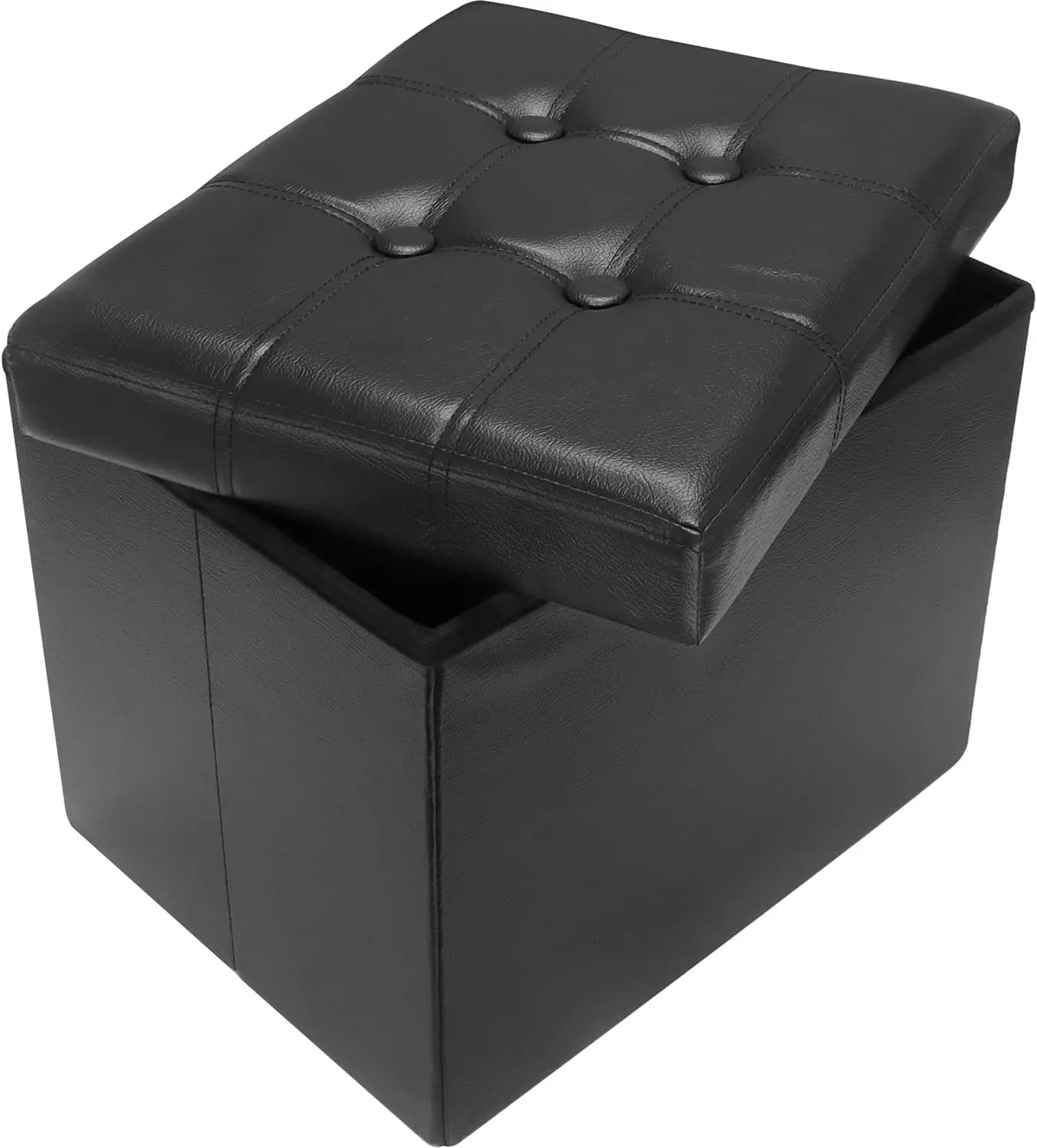
Storage benches provide more generous and comfortable seating than hall trees but with fewer hanging options. This makes them particularly suitable for entryways where you primarily need a place to sit while putting on shoes and storing seasonal items.
The versatility of entryway bench storage solutions makes them a popular choice for many homes, and implementing smart entryway storage seating solutions can dramatically improve your daily routine with thoughtful organization that blends seamlessly with your décor.
Entryway Cabinets with Integrated Seating: Sophisticated Organization
Entryway cabinets with integrated seating represent a sophisticated hybrid solution that combines generous cabinet storage with comfortable seating. These pieces often resemble built-in furniture, creating a polished, intentional look for your entryway.
These versatile pieces offer storage configurations to suit various needs:
- Closed cabinets conceal clutter and protect items from dust
- Open shelving provides easy access and display opportunities
- Combination designs balance visibility and concealment
- Specialized storage features like mail slots, key hooks, or charging stations
Many entryway cabinet units can be customized with specific interior components to address particular storage needs. Adjustable shelving, drawer dividers, and specialized compartments can transform a basic cabinet into a highly personalized organization system.
These substantial pieces typically require 16-24 inches of depth and create a cohesive, built-in aesthetic that elevates your entryway’s overall design. The materials used must withstand daily wear and occasional moisture exposure from shoes or outerwear, making hardwoods, quality veneers, and moisture-resistant finishes ideal choices.
For homeowners seeking refined aesthetics alongside practical storage, shoe storage benches with cabinet features provide an elegant solution that keeps footwear organized while maintaining a sophisticated appearance.
Floating and Wall-Mounted Benches: Space-Saving Solutions
Floating and wall-mounted benches represent the ultimate space-saving solution for entryways with limited floor area. By eliminating legs and supporting weight directly from wall attachments, these innovative designs create an airy, open feeling while providing functional seating and storage opportunities.
These space-efficient options offer unique advantages:
- Visual lightness that makes small spaces appear larger
- Floor clearance for easy cleaning underneath
- Modern, streamlined aesthetic that works well in contemporary homes
- Opportunity for creative under-bench storage with baskets or shoe racks
Installation requires careful consideration of wall structure and weight capacity. Most floating benches support between 200-300 pounds when properly mounted to wall studs or solid masonry. Installation typically requires basic tools and intermediate DIY skills, though professional mounting is recommended for heavier models.
The space beneath floating benches creates natural storage opportunities. Wire baskets, fabric bins, or dedicated shoe racks can maximize this area while maintaining the clean, open look that makes floating benches so appealing.
For entryways where every square inch matters, narrow entryway benches provide efficient seating and storage while keeping pathways clear and maintaining an open, uncluttered appearance.
Ottomans and Storage Poufs: Flexible and Movable Solutions
Ottomans and storage poufs offer unmatched flexibility for entryway seating and organization. As the most mobile option among multi-functional entry furniture, these versatile pieces can be easily repositioned to accommodate changing needs or traffic patterns.
Available in countless sizes, shapes, and materials, storage ottomans and poufs can adapt to virtually any space constraint. Most feature hinged lids that reveal interior storage perfectly sized for smaller items like gloves, scarves, pet leashes, or children’s accessories that might otherwise clutter your entryway.
One significant advantage of these pieces is their multi-room versatility. An ottoman can serve as entryway seating during busy morning departures, then transition to the living room as extra seating or a footrest in the evening. This dual-purpose functionality makes them particularly valuable in smaller homes where furniture must work harder.
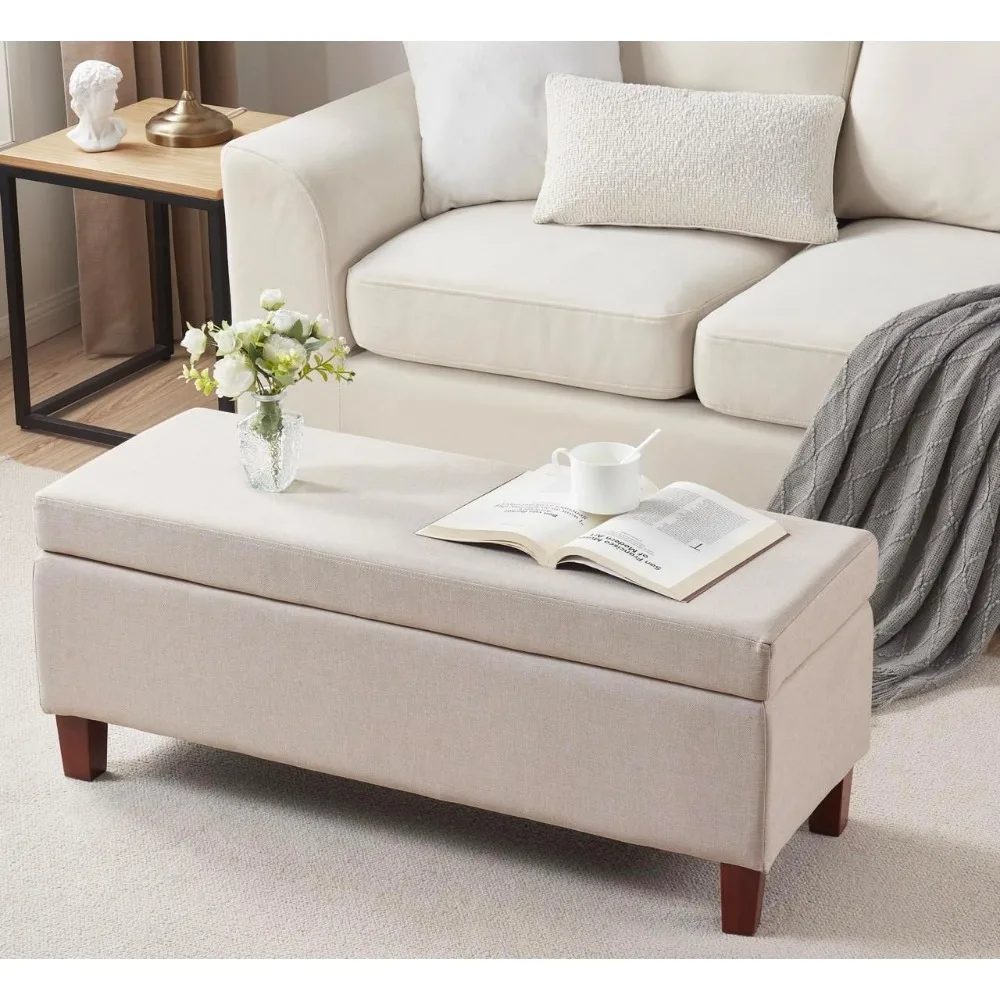
Beyond their practical benefits, ottomans and poufs add significant decorative value to entryways. Available in countless fabrics, textures, and colors, they provide an opportunity to introduce accent colors or interesting textiles that complement your overall design scheme.
For those with limited space or changing needs, transforming a small foyer with multi-use furniture can dramatically improve both functionality and appearance without committing to larger, permanent pieces.
Multi-functional Console Tables: Slim Profiles with Maximum Utility
Console tables with integrated seating and storage features represent an ideal solution for narrow entryways where depth is severely limited. With typical depths of just 10-14 inches, these slim-profile pieces maximize functionality while minimizing their footprint.
Clever designs in this category include:
- Tables with tucked stools that slide completely underneath when not in use
- Nesting designs where smaller surfaces pull out for additional functionality
- Drawers or shelves incorporated into ultra-thin profiles
- Flip-top surfaces that reveal hidden storage compartments
The table surface provides essential space for daily essentials like keys, mail, and decorative items, while integrated storage handles less visually appealing necessities. Some designs incorporate charging stations, mail slots, or key hooks to further enhance functionality.
Material combinations often include mixed media—wood frames with glass tops, metal structures with upholstered seating—to maximize durability in high-traffic areas while maintaining visual lightness.
These space-conscious solutions prove that even the narrowest entryway can accommodate multi-functional furniture when designed with dimensional constraints in mind.
Essential Features to Look for in Multi-Functional Entry Seating
When evaluating multi-functional entry seating options, certain key features differentiate exceptional pieces from merely adequate ones. Understanding these critical elements helps ensure your selection will truly enhance your entryway’s functionality.
Storage Capabilities
The most versatile entry furniture offers varied storage options:
– Hidden compartments for items requiring concealment
– Drawers with smooth operation for small essentials
– Open cubbies for frequently accessed items or decorative displays
– Specialized storage for specific needs (shoe compartments, mail slots)
Hanging Elements
For many households, vertical storage proves essential:
– Sturdy hooks or pegs for coats, bags, and accessories
– Proper spacing to accommodate multiple items without crowding
– Weight capacity appropriate for intended use (heavy winter coats vs. light scarves)
– Height positioning that works for all family members
Seating Surface Considerations
The sitting area must balance comfort with practicality:
– Appropriate height (18-20 inches) for comfortable shoe changes
– Durable materials that resist wear from outdoor clothing
– Cushioning that maintains shape with repeated use
– Cleanable surfaces appropriate for an entryway environment
Structural Integrity
Quality construction ensures safety and longevity:
– Solid joinery that resists wobbling or creaking
– Weight capacity adequate for intended users
– Stable design that prevents tipping, particularly important for taller pieces
– Quality hardware that withstands frequent use
For maximum functionality in limited spaces, space-saving entryway seating solutions incorporate these essential features while maintaining a proportional relationship to available square footage.
Choosing the Perfect Multi-Functional Entry Seating for Your Space
Finding the ideal entry furniture requires a methodical approach that balances spatial constraints, functional requirements, and aesthetic preferences. Follow these steps to identify the perfect piece for your unique situation:
1. Measure Your Entryway Dimensions Precisely
Before shopping, gather these critical measurements:
– Available width (wall-to-wall)
– Maximum depth that won’t impede traffic flow
– Height restrictions (windows, switches, outlets)
– Door swing clearance (allow 30 inches minimum)
– Traffic patterns through the space
2. Assess Your Daily Storage Needs
Create an inventory of items regularly stored in your entry:
– Number of household members using the space
– Typical number of coats, bags, and shoes requiring storage
– Seasonal items needing accommodation (umbrellas, winter gear)
– Small essentials requiring organization (keys, mail, sunglasses)
3. Match Furniture Style with Home Aesthetics
Your entryway establishes your home’s design narrative:
– Identify architectural features to complement (moldings, flooring)
– Consider sight lines from entry to adjacent rooms
– Determine whether you want the piece to blend seamlessly or create a focal point
– Select materials and finishes compatible with existing elements
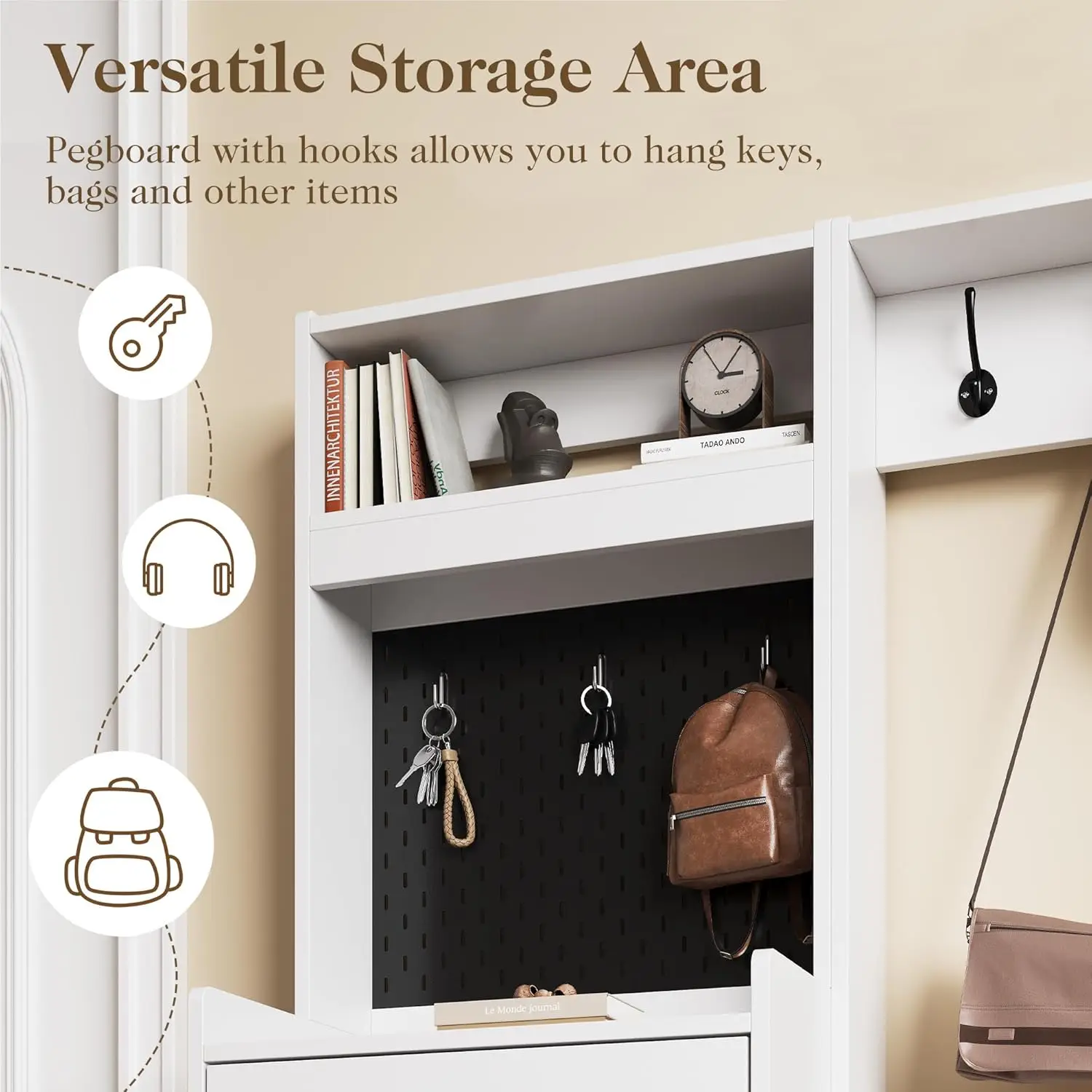
4. Evaluate Traffic Flow Requirements
Busy entryways demand careful space planning:
– Allow 36 inches minimum for primary pathways
– Consider multiple users navigating the space simultaneously
– Ensure doors can open fully without obstruction
– Visualize how the furniture will function during rush periods
Corner entryway benches offer an excellent solution for maximizing awkward spaces while maintaining clear traffic paths. For specialized environments like laundry or back entries, multi-functional seating for mudrooms provides robust solutions designed for high-activity zones.
Entryway Bench with Cushion, Mudroom Bench with Cushion, Shoe Bench for Entryway
$1,186.63 Select options This product has multiple variants. The options may be chosen on the product pageCoat Rack Shoe Bench, Corner Entryway Bench, Corner Hall Tree, Shoe Bench for Entryway
$313.58 Select options This product has multiple variants. The options may be chosen on the product pageEntryway Bench with Back, Modern Entryway Bench, Shoe Bench for Entryway
Price range: $463.13 through $474.44 Select options This product has multiple variants. The options may be chosen on the product pageEntryway Bench with Shelf Storage, Shoe Bench for Entryway, Shoe Storage Bench
$194.08 Select options This product has multiple variants. The options may be chosen on the product pageCorner Entryway Bench, Entryway Bench with Cushion, Modern Entryway Bench, Shoe Bench for Entryway
$476.34 Select options This product has multiple variants. The options may be chosen on the product pageBench with Hooks and Storage, Entryway Hall Tree, Mudroom Bench with Cubbies, Mudroom Bench with Shoe Storage
$818.38 Select options This product has multiple variants. The options may be chosen on the product page
Styling Your Multi-Functional Entry: Creating a Cohesive Look
Once you’ve selected the perfect multi-functional seating, thoughtful styling elevates your entryway from merely organized to truly welcoming. Creating a cohesive look involves layering complementary elements that enhance both functionality and visual appeal.
Mirror Placement
Mirrors serve both practical and decorative purposes in entryways:
– Position mirrors at eye level for quick appearance checks
– Use large mirrors to reflect light and visually expand small spaces
– Select frames that complement your furniture’s style and finish
– Consider mirror shapes that contrast with your furniture’s silhouette (round mirrors above rectangular benches create visual interest)
Lighting Considerations
Proper lighting transforms entryway functionality:
– Layer lighting with overhead fixtures, wall sconces, and table lamps
– Ensure adequate illumination for practical tasks like finding keys
– Consider motion-activated options for convenience
– Select fixtures that reinforce your design aesthetic
Textiles and Soft Elements
Rugs and cushions add comfort while defining the space:
– Choose entryway rugs in durable, easy-clean materials like wool or indoor/outdoor fibers
– Select appropriately sized rugs (allow at least 3 feet beyond furniture edges)
– Coordinate cushion fabrics with other textiles while prioritizing durability
– Consider seasonal textile rotations to refresh the space throughout the year
Maintaining a balance between personal expression and functional organization ensures your entryway remains both beautiful and practical. Aim for an 80/20 ratio: 80% organization and 20% personalization through carefully curated decorative elements.
Care and Maintenance for Long-Lasting Entry Furniture
Proper maintenance ensures your investment in quality entry furniture provides years of service. Different materials require specific care approaches to maintain appearance and structural integrity.
Wood Care
For wooden entry furniture:
– Dust regularly with a soft, slightly damp cloth
– Clean spills immediately to prevent water damage or staining
– Apply furniture polish or wax every 3-6 months (following product recommendations)
– Avoid direct sunlight exposure which can fade finishes over time
– Maintain consistent indoor humidity levels to prevent warping or cracking
Metal Components
For hardware and metal structures:
– Wipe regularly with a dry cloth to prevent dust accumulation
– Address any rust spots immediately with appropriate metal cleaners
– Periodically tighten any loose screws or hardware
– Apply metal polish to maintain luster on decorative elements
Upholstered Surfaces
For fabric-covered seating and cushions:
– Vacuum regularly using upholstery attachments
– Treat spills immediately following fabric-appropriate guidelines
– Apply fabric protector treatments to guard against stains
– Schedule professional cleaning annually for heavily used pieces
– Rotate removable cushions to ensure even wear
Establishing a seasonal maintenance routine helps catch minor issues before they become significant problems. Each season, examine your entry furniture for loose hardware, worn spots, or damage that might require attention.
Custom Solutions: When Standard Options Don’t Fit Your Space
Sometimes standard furniture pieces don’t adequately address unique spatial challenges or specific organizational needs. Custom or modified solutions can transform problematic entryways into highly functional spaces.
Challenging entryway configurations that might benefit from custom approaches include:
- Extremely narrow corridors with limited depth
- Awkward architectural features like sloped ceilings or bump-outs
- Historic homes with unusual dimensions or features
- Extremely small apartment entries
- Spaces requiring specific storage for specialized equipment
Repurposing existing furniture often provides cost-effective custom solutions. Dressers can become bench-storage combinations with simple modifications. Bookshelves can transform into cubbies with the addition of hooks and baskets. Kitchen cabinets can become entryway storage with the addition of a cushioned top.
Modular systems offer another approach to customization, allowing you to configure components to fit unusual spaces precisely. Many furniture retailers now offer semi-custom options where standard pieces can be ordered with adjustable dimensions or configurable components.
For budget-conscious homeowners, DIY modifications to standard pieces can yield impressive results. Simple projects like adding hooks to a basic bench, installing dividers in deep drawers, or creating cushions for hard surfaces can significantly enhance functionality without requiring advanced woodworking skills.
FAQ: Common Questions About Multi-Functional Entry Seating
What are the best options for very small entryways under 30 inches wide?
For extremely narrow spaces, consider wall-mounted floating benches, slim console tables with tucked stools, or corner units designed specifically for tight spaces. Vertical storage becomes essential in small areas—look for pieces that maximize height with hooks and shelving above compact seating areas.
How much storage can I realistically expect from entry furniture?
Storage capacity varies dramatically by design. A standard storage bench typically provides 3-8 cubic feet of interior space, enough for 6-10 pairs of shoes and seasonal accessories. Hall trees with multiple components offer even greater capacity through combined cabinet, shelf, and hanging storage. For accurate assessment, measure your most commonly stored items and compare to interior dimensions before purchasing.
Can I modify standard furniture pieces to better fit my entryway?
Absolutely! Common modifications include adding hooks to benches, installing dividers in deep storage compartments, replacing standard knobs with hooks, and adding cushions to hard surfaces. More advanced DIY projects might involve combining separate pieces into custom configurations or building custom-sized cushions for specific dimensions.
How do I ensure my entry furniture will hold up to heavy daily use?
Look for quality construction indicators: solid wood rather than particle board, reinforced joinery methods like dovetails or mortise-and-tenon rather than just glue, and quality hardware designed for frequent use. Avoid pieces with thin materials or visible shortcuts in construction. For upholstered pieces, choose commercial-grade fabrics with high rub counts (30,000+ for high-traffic areas).
What’s the best solution for organizing multiple pairs of shoes?
For efficient shoe storage, consider shoe benches designed specifically for entryways. These specialized pieces often include tilted shelves, cubbies sized for footwear, or pull-out racks that maximize storage while minimizing odors. For families with many shoes, combination pieces with both hidden and visible shoe storage allow for seasonal rotation and varying levels of accessibility.
By thoughtfully selecting multi-functional entry seating that addresses your specific needs, you can transform your entryway into an organized, welcoming space that enhances your daily routine and creates a positive first impression for your home.

